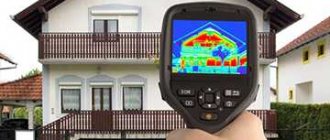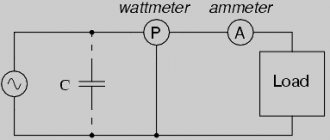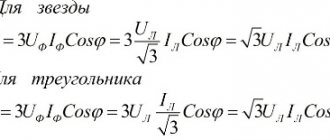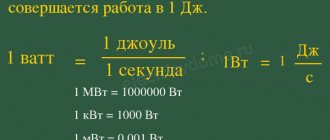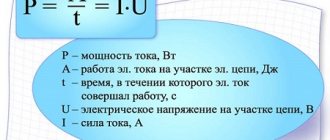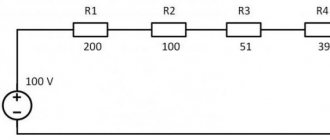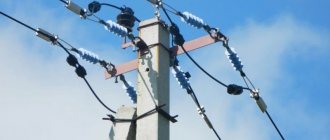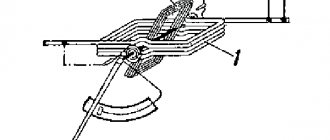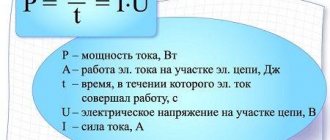The power of technical equipment or power plants (devices, units) supplied by them to perform work is indicated in their technical characteristics. But this does not mean that all of it is used for its intended purpose to achieve results. Only useful power is used to perform work.
General definition of power
Definition and formula of useful power
It is worth considering the concept of useful power and the formula using the example of an electrical circuit. The power that the power source (PS), in particular current, develops in a closed circuit will be the total power.
Circuit diagram
The circuit includes: a current source with EMF (E), an external circuit with a load R and an internal circuit of a power supply whose resistance is R0. The formula for total (total) power is:
Ptotal = E*I.
Here I is the value of the current passing through the circuit (A), and E is the value of the emf (B).
Attention! The voltage drop in each section will be equal to U and U0, respectively.
So the formula will take the form:
Ptotal = E*I = (U + U0) *I = U*I + U0*I.
It can be seen that the value of the product U*I is equal to the power supplied by the source to the load and corresponds to the useful power Ppol.
The value equal to the product U0*I corresponds to the power that is lost inside the power supply for heating and overcoming the internal resistance R0. This is the power loss P0.
The values substituted into the formula show that the sum of useful and lost power makes up the total power of the IP:
Ptotal=Pfloor+P0.
Important! When operating any apparatus (mechanical or electrical), the useful power will be that which remains to perform the required work after overcoming the factors causing losses (heating, friction, counteracting forces).
Current power
Any electrical device (lamp, electric motor, etc.) is designed to consume a certain energy per unit of time. Therefore, along with the work of current, the concept of current power is very important.
Current power is the work done in 1 second. Denoted as P. The unit of measurement is Watt (W).
Numerically, the current power is equal to the ratio of the current work during time ∆t to this time interval:
This expression for power can be rewritten in several equivalent forms if we use Ohm's law for a section of the circuit:
Example No. 3. When the current in the electrical circuit is 0.3 A, the resistance of the lamp is 10 Ohms. Determine the power of electric current released on the lamp filament.
Expressing the current strength in terms of the charge passed per unit time, we obtain:
The current power is equal to the power on the external circuit. It is also called load power, net power or thermal power. It can be expressed through EMF:
The current power in the external circuit will be maximum if the resistance of the external circuit is equal to the internal resistance: R = r.
Internal circuit current power:
Example No. 4. The direct current emf is ε = 2 V, and its internal resistance is r = 1 Ohm. The current power in the resistor connected to the source is P0 = 0.75 W. What is the minimum current in the circuit?
We use the formula to find useful power:
Let's apply Ohm's law to the complete circuit:
Power supply parameters
Electric current power
In practice, you often have to think about what the power of the current source should be, how many watts (W) or kilowatts (kW) are needed to ensure uninterrupted operation of the device. To understand the essence, you need to have an understanding of such concepts used in physics as:
- total circuit energy;
- EMF and voltage;
- internal resistance of the power supply;
- losses within the individual entrepreneur;
- useful power.
Regardless of what kind of energy the source produces (mechanical, electrical, thermal), its power should be selected with a small margin (5-10%).
Total circuit energy
When a load is connected to the circuit, which will consume energy from a current source (IT), the current will do work. The energy released by all consumers and circuit elements included in the circuit (wires, electronic components, etc.) is called total energy. The energy source can be any: generator, battery, thermal boiler. The total energy value will be the sum of the energy spent by the source on losses and the amount spent on performing specific work.
EMF and voltage
What is the difference between these two concepts?
EMF is electromotive force, it is the voltage that external forces (chemical reaction, electromagnetic induction) create inside a current source (IT). EMF is the force of movement of electrical charges in IT.
EMF definition
For your information. It seems possible to measure the value of E (EMF) only in idle mode (idle). Connecting any load causes a loss of voltage inside the power supply.
Voltage (U) is a physical quantity representing the potential difference ϕ1 and ϕ2 at the output of the voltage source (VS).
Potential difference
Net power
The definition of the concept of total power is used not only in relation to electrical circuits. It is also applicable to electric motors, transformers and other devices capable of consuming both active and reactive components of energy.
Losses inside the power supply
Similar losses occur at the internal resistance of a two-terminal network. For a battery, this is the electrolyte resistance; for a generator, this is the winding resistance, the lead wires of which come out of the housing.
Internal power supply resistance
You won’t be able to simply measure R0 with a tester; you definitely need to know it to calculate P0 losses. Therefore, indirect methods are used.
An indirect method for determining R0 is as follows:
- in x.x mode measure E (B);
- when the load Rн (Ohm) is turned on, Uout (V) and current I (A) are measured;
- The voltage drop inside the source is calculated using the formula:
U0=E-Uout.
At the last stage, R0=U0/I is found.
Circuit for measuring R0
Relationship between useful power and efficiency
Efficiency factor (efficiency) is a dimensionless quantity, expressed numerically as a percentage. Efficiency is denoted by the letter η.
kVA to kW - how to correctly convert power
The formula looks like:
η = A/Q,
Where:
- A – useful work (energy);
- Q – energy expended.
As the efficiency increases in various engines, it is permissible to build the following line:
- electric motor – up to 98%;
- ICE – up to 40%;
- steam turbine – up to 30%.
In terms of power, efficiency is equal to the ratio of useful power to the total power delivered by the source. In any case, η ≤ 1.
Important! Efficiency and Ppol are not the same thing. In different work processes, they achieve the maximum of one or the other.
Obtaining maximum energy at the output of the IP
For your information. To increase the efficiency of cranes, injection pumps or aircraft engines, it is necessary to reduce the friction forces of mechanisms or air resistance. This is achieved by using a variety of lubricants, installing higher-class bearings (replacing sliding with rolling), changing the wing geometry, etc.
The maximum energy or power at the output of the IP can be achieved by matching the load resistance Rн and the internal resistance R0 of the IP. This means that Rн = R0. In this case, the efficiency is 50%. This is quite acceptable for low-current circuits and radio devices.
However, this option is not suitable for electrical installations. To avoid wasting large amounts of power, the operating mode of generators, rectifiers, transformers and electric motors is such that the efficiency is approaches 95% and above.
Graph of dependence of Рpol and η on current in the circuit
Achieving maximum efficiency
The formula for the efficiency of a current source is:
η = Pн/Ptotal = R/Rн+r,
Where:
- Pn – load power;
- Ptotal – total power;
- R is the total resistance of the circuit;
- Rн – load resistance;
- r – internal resistance of IT.
As can be seen from the graph shown in Fig. higher, the power Pn tends to zero as the current in the circuit decreases. The efficiency, in turn, will reach its maximum value when the circuit is open and the current is zero; if there is a short circuit in the circuit, it will become zero.
If we look at an elementary heat engine consisting of a piston and a cylinder, then its compression ratio is equal to the expansion ratio. Increasing the efficiency of such a motor is possible if:
- initially high parameters: pressure and temperature of the working fluid before expansion begins;
- bringing their values closer to environmental parameters at the end of expansion.
Achieving ηmax is possible only with the most effective change in the pressure of the working component in the rotational movement of the shaft.
For your information. The thermal efficiency increases with increasing proportion of heat supplied to the working fluid, which is converted into work. The supplied heat is divided into two types of energy: internal in the form of temperature and pressure energy.
Mechanical work, in fact, is performed only by the second type of energy. This gives rise to a number of disadvantages that slow down the process of increasing efficiency:
- some of the pressure goes to the external environment;
- achieving maximum efficiency is impossible without increasing the percentage of pressure energy used for conversion into work;
- it is impossible to increase the efficiency of heat engines without changing S the surface of pressure application, and without removing this surface from the point of rotation;
- the use of only a gaseous working fluid does not contribute to increasing η of heat engines.
To achieve a high efficiency of a heat engine, you need to make a number of decisions. The following device models contribute to this:
- introduce another working fluid with different physical properties into the expansion cycle;
- make the most of both types of energy of the working fluid before expansion;
- generate additional working fluid directly during gaseous expansion.
Information. All modifications to internal combustion engines in the form of: a turbocharger, the organization of multiple or distributed injection, as well as increasing air humidity, bringing the fuel to a state of steam during injection, did not produce tangible results in a sharp increase in efficiency.
Internal combustion engine efficiency
Electrical circuit efficiency
The efficiency factor under consideration is primarily associated with physical quantities characterizing the speed of conversion or transmission of electricity. Among them, power, measured in watts, comes first. There are several formulas to determine it: P = U x I = U2/R = I2 x R.
Electrical circuits may have different voltages and charge amounts, and accordingly, the work performed is also different in each case. Very often there is a need to estimate the speed at which electricity is transmitted or converted. This speed represents the electrical power corresponding to the work done in a certain unit of time. In the form of a formula, this parameter will look like this: P=A/∆t. Therefore, work is displayed as the product of power and time: A=P∙∆t. The unit of work used is the joule (J).
In order to determine how efficient a device, machine, electrical circuit or other similar system is in relation to power and operation, efficiency is used. This value is defined as the ratio of usefully expended energy to the total amount of energy entering the system. Efficiency is denoted by the symbol η, and is defined mathematically as the formula: η = A/Q x 100% = [J]/[J] x 100% = [%], in which A is the work performed by the consumer, Q is the energy given by the source . In accordance with the law of conservation of energy, the efficiency value is always equal to or below unity. This means that useful work cannot exceed the amount of energy expended in doing it.
In this way, the power losses in any system or device are determined, as well as the degree of their usefulness. For example, in conductors, power losses occur when electrical current is partially converted into thermal energy. The amount of these losses depends on the resistance of the conductor; they are not part of the useful work.
There is a difference expressed by the formula ∆Q=AQ, which clearly shows the power loss. Here the relationship between the increase in power losses and the resistance of the conductor is very clearly visible. The most striking example is an incandescent lamp, the efficiency of which does not exceed 15%. The remaining 85% of the power is converted into thermal, that is, infrared radiation.
Load efficiency
How to calculate power consumption
Whatever the power of the source, the efficiency of electrical appliances will never be 100%.
Exception. The heat pump principle used in the operation of refrigerators and air conditioners brings their efficiency closer to 100%. There, heating one radiator leads to cooling of the other.
Otherwise, energy is spent on extraneous effects. To reduce this expense, you need to pay attention to the following factors:
- when arranging lighting - on the design of lamps, the design of reflectors and the color of the premises (reflective or light-absorbing);
- when organizing heating - for thermal insulation of heat pipes, installation of heat recovery exhaust devices, insulation of walls, ceilings and floors, installation of high-quality double-glazed windows;
- when organizing electrical wiring, select the correct brand and cross-section of conductors according to the future connected load;
- when installing electric motors, transformers and other AC consumers - by the cosϕ value.
Reducing the cost of losses clearly leads to an increase in efficiency when the energy source performs work on the load.
Reducing the influence of factors causing power loss increases the percentage of useful power required to perform work. This is possible by identifying the causes of losses and eliminating them.
